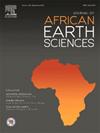Facies analysis of Late Pleistocene mixed carbonate-siliciclastic transgressive-regressive sequence along the coast near Mogadishu (Somalia)
IF 2.2
4区 地球科学
Q2 GEOSCIENCES, MULTIDISCIPLINARY
引用次数: 0
Abstract
The raised sedimentary complex outcropping along the coastal belt just south of the Mogadishu airport is a roughly 10-m-thick carbonate–siliciclastic, coral-bearing depositional sequence. This complex is defined by eight primary depositional facies that form a transgressive–regressive sedimentary cycle, capped by a regressive surface that gently dips seaward.
Facies analysis reveals a transgressive system tract consisting of a stratal set of siliciclastic sand deposited above a wave-ravinement surface, as indicated by an eroded quartz sand substratum. The transgressive succession continues with loose siliciclastic sand that contains a rich mollusk fauna intermixed with coarse skeletal debris of stony corals and both encrusted and articulated coralline algae. The macrofossil assemblage indicates diverse shoreface environments, where water depth, bottom morphology, and distance from the shoreline are critical in characterizing each facies.
Comparisons with the modern biological zonation of the shallow shelf along the southern Somali coast have helped clarify the depositional characteristics of the Pleistocene facies succession. The distribution of fossil coral communities—often with colonies still in growth position—suggests a series of shallow-water facies related to back reef–shore environments that migrated landward over time. In contrast, the highstand system tract differs from the underlying facies by exhibiting a drastic decrease in the siliciclastic granular fraction and corals in growth position, which is offset by an increase in articulated and encrusted coralline algae that comprise most of the sediment source. Locally, skeletal rubble rich in large coralline algal nodules is typical of the regressive phase. The deposition of these facies results in a smoothing of seafloor roughness due to the burial of coral buildups by skeletal sand that shows less facies diversification.
The marine succession—affected in its upper part by the calichification process—culminates in a marine terrace capped by aeolian sands deposited during various depositional–erosional events. Some of these deposits correlate with raised beachrock that outcrops discontinuously just above present sea level and corresponds to a minor Holocene sea level highstand.
To assess the time interval required for the deposition of this transgressive–regressive cycle, which is related to a Late Pleistocene sea level positive peak, sedimentation rates and U–Th dating of two samples of massive Porites lutea from the transgressive system tract have been considered. The ages of approximately 114 kyr indicate a flooding event on the southern Somali coast during the transition between stages 5e and 5d of the Last Interglacial, while the overall duration of the sedimentary cycle is likely much less than 10 kyr. Furthermore, by matching the investigated cycle with positive peaks on significant global and local sea level curves, additional insights have been made regarding relative sea level fluctuations following the development of the Pleistocene sedimentary wedge.
求助全文
约1分钟内获得全文
求助全文
来源期刊

Journal of African Earth Sciences
地学-地球科学综合
CiteScore
4.70
自引率
4.30%
发文量
240
审稿时长
12 months
期刊介绍:
The Journal of African Earth Sciences sees itself as the prime geological journal for all aspects of the Earth Sciences about the African plate. Papers dealing with peripheral areas are welcome if they demonstrate a tight link with Africa.
The Journal publishes high quality, peer-reviewed scientific papers. It is devoted primarily to research papers but short communications relating to new developments of broad interest, reviews and book reviews will also be considered. Papers must have international appeal and should present work of more regional than local significance and dealing with well identified and justified scientific questions. Specialised technical papers, analytical or exploration reports must be avoided. Papers on applied geology should preferably be linked to such core disciplines and must be addressed to a more general geoscientific audience.
 求助内容:
求助内容: 应助结果提醒方式:
应助结果提醒方式:


